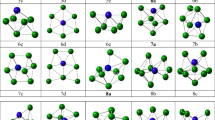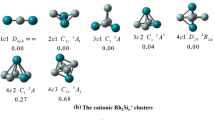Abstract
DFT calculations have been carried out over the IrnV (n = 2–10) clusters in order to predict their stability, electronic, and catalytic properties. Based on the fragmentation energy (ΔEf) and the second-order difference energy (Δ2E), the results show that the V-doped iridium clusters with sizes of n = 5 and 7 were found more stable than their neighboring clusters. Our results also exhibit that the calculated energy gaps (Eg) for these clusters are in the range 0.074–0.603 eV, suggesting that the metallic character can manifest in these binary clusters. Therefore, the IrnV clusters can be utilized as catalysts in several catalytic reactions. MEP analysis exhibits that the highest positive charge resides on the V atom, thus the V atom in the binary clusters can be considered as the most active site for the nucleophilic attack. So, it represents a favorable electrophilic adsorption site that can strongly interact with the electron-rich molecules. The influence of the N2H4 adsorption over the electronic properties of IrnV clusters was also investigated. The results show that the adsorption energies (Eads) vary between − 21.3 and − 46.6 kcal mol−1, suggesting a chemisorption process. The change in enthalpy (ΔHads) is in the range of − 24.6 to − 51.0 kcal mol−1, indicating that the interaction between the IrnV clusters and the N2H4 molecule is very strong, and the formed complexes by chemisorption between the clusters and the N2H4 molecule are thermodynamically stable at standard conditions. The energy gaps of clusters are sharply changed upon adsorption of hydrazine onto the surface of the clusters, implying a great sensitivity of these clusters toward N2H4 molecule. The calculated dipole moments were also largely increased after chemisorption of the N2H4 molecule over the clusters.





Similar content being viewed by others
References
Palpant B, Prevel B, Lerme J, Cottancin E, Pellarin M, Treilleux M, Perez A, Vialle JL, Broyer M (1998) Optical properties of gold clusters in the size range 2-4 nm. Phys Rev B 57:1963
Chettibi M, Boudjahem A, Bettahar M (2011) Synthesis of Ni/SiO2 nanoparticles for catalytic benzene hydrogenation. Transit Met Chem 36:163–169
Zhang JY, Fang Q, Kenyon AJ, Boyd IW (2003) Visible photoluminescence from nanocrystalline Ge grown at room temperature by photo-oxidation of SiGe using a 126 nm lamp. Appl Surf Sci 208–209:364–368
Dong CD, Gong XG (2008) Magnetism enhanced layer-like structure of small cobalt clusters. Phys Rev B 78:020409
Gopidas KR, Whitesell JM, Fox MA (2003) Synthesis, characterization and catalytic applications of a palladium-nanoparticles-cored dendrimer. Nano Lett 3:1757–1760
Mokrane T, Boudjahem A, Bettahar M (2016) Benzene hydrogenation over alumina-supported nickel nanoparticles prepared by polyol method. RSC Adv 6:59858–59864
Alexeev O, Li F, Amiridis MD, Gates B (2005) Effects of Adsorbates on supported platinum and iridium clusters: characterization in reactive atmospheres and during alkene hydrogenation catalysis by X-ray absorption spectroscopy. J Phys Chem B 109:2338–2349
Cho S, Lee J, Lee YS, Kim D (2006) Characterization of iridium catalyst for decomposition of hydrazine hydrate for hydrogen generation. Catal Lett 109:181–186
Contour JP, Pannetier G (1972) Hydrazine decomposition over a supported iridium catalyst. J Catal 24:434–445
Jang Y, Kim T, Sun M, Lee J, Cho SJ (2009) Preparation of iridium catalyst and its catalytic activity over hydrazine hydrate decomposition for hydrogen production and storage. Catal Today 146:196–201
Wang L, Zhao X, Zheng M, Cheng R, Zhou L, Zhang T (2005) Microcalorimetric studies of the iridium catalyst for hydrazine decomposition reaction. Thermochim Acta 434:119–124
Siang J, Lee C, Wang C-H, Wang W-T, Deng C-Y, Yeh C, Wang C-B (2010) Hydrogen production from steam reforming of ethanol using a ceria-supported iridium catalyst: effect of different ceria supports. Int J Hydrog Energy 35:3456–3462
Himeda Y (2009) Highly efficient hydrogen evolution by decomposition of formic acid using an iridium catalyst with 4,4-dihydroxy-2,2-bipyridine. Green Chem 11:2018–2022
Alexeev O, Gates BC (1998) Iridium clusters supported on γ-Al2O3: structural characterization and catalysis of toluene hydrogenation. J Catal 176:310–320
Singh SK, Xu Q (2010) Bimetallic nickel-iridium nanocatalysts for hydrogen generation by decomposition of hydrous hydrazine. Chem Commun 46:6545–6547
Tandon PK, Srivastava M, Singh SB, Singh S (2008) Liquid-phase and microwave assisted oxidation of some hydrocarbons, aromatic aldehydes and phenols by cerium (IV) catalyzed by iridium (III) in acidic medium. Synth Commun 38(208):2125–2137
Tandon PK, Dwivedi PB, Singh S (2009) Liquid-phase oxidation of some aromatic aldehydes, hydrocarbons, and alcohols by cerium (IV) catalyzed by iridium (III) in acidic medium. Synth Commun 39:1920–1928
Sakurai Y, Suzaki T, Ikenaga N, Suzuki T (2000) Dehydrogenation of ethylbenzene with an activated carbon-supported vanadium catalyst. Appl Catal A 192:281–288
Jorge FE, Venancio JR (2018) Structure, stability catalytic activity and polarizability of small iridium clusters. Chin Phys B 27:063102
Du J, Sun X, Chen J, Jiang G (2010) A theoretical study on small iridium clusters: structural evolution, electronic and magnetic properties and reactivity predictors. J Phys Chem A 114:12825–12833
Pawluk T, Hirata Y, Wang L (2005) Studies of iridium nanoparticles using density functional theory calculations. J Phys Chem B 109:20817–20823
Okumura M, Irie Y, Kitagawa Y, Fujitani T, Maeda Y (2006) DFT studies of interaction of Ir cluster with O2, CO and NO. Catal Today 111:311–315
Feng J-N, Huang X-R, Li Z-S (1997) A theoretical study on the clusters Irn with n = 4,6, 8, 10. Chem Phys Lett 276:334–338
He L, Huang Y, Liu X, Li L, Wang A, Wang X, Mou C-Y, Zhang T (2014) Structural and catalytic properties of supported Ni-Ir alloy catalysts for H2 generation via hydrous hydrazine decomposition. Appl Catal B 147:779–788
Davis J, Horswell S, Piccolo L, Johnston R (2015) Computational study of the adsorption of benzene and hydrogen on palladium-iridium nanoalloys. J Organomet Chem 792:190–193
Estejab A, Botte G (2016) DFT calculations of ammonia oxidation reactions on bimetallic clusters of platinum and iridium. Comput Theor Chem 1091:31–40
Bouderbala W, Boudjahem A, Soltani A (2014) Geometries, stabilities, electronic and magnetic properties of small PdnIr (n = 1-8) clusters from first-principles calculations. Mol Phys 112:1789–1798
Becke AD (1988) Density-functional exchange-energy approximation with correct asymptotic behavior. Phys Rev A 38:3098–3100
Lee C, Yang W, Parr RG (1988) Development of the Colle-Salvetti correlation-energy formula into a functional of the electron density. Phys Rev B 37:785–789
Frisch MJ, Trucks GW, Schlegel HB, Scuseria GE, Robb MA, Cheeseman JR, Scalmani G, Barone V, Mennucci B, Petersson GA, Nakatsuji H, Caricato M, Li X, Hratchian HP, Izmaylov AF, Bloino J, Zheng G, Sonnenberg JL, Hada M, Ehara M, Toyota K, Fukuda R, Hasegawa J, Ishida M, Nakajima T, Honda Y, Kitao O, Nakai H, Vreven T, Jr JA, Montgomery JE, Peralta F, Ogliaro M, Bearpark JJ, Heyd E, Brothers KN, Kudin VN, Staroverov T, Keith R, Kobayashi J, Normand K, Raghavachari A, Rendell JC, Burant SS, Iyengar J, Tomasi M, Cossi N, Rega JM, Millam M, Klene JE, Knox JB, Cross V, Bakken C, Adamo J, Jaramillo R, Gomperts RE, Stratmann O, Yazyev AJ, Austin R, Cammi C, Pomelli JW, Ochterski RL, Martin K, Morokuma VG, Zakrzewski GA, Voth P, Salvador JJ, Dannenberg S, Dapprich AD, Daniels O, Farkas JB, Foresman JV, Ortiz J, Cioslowski DJ (2013) Fox, Gaussian 09, Revision D.01. Gaussian, Inc., Wallingford
Hay PJ, Wadt WR (1985) Ab initio effective core potentials for molecular calculations. Potentials for the transition metal atoms Sc to Hg. J Chem Phys 82:270–283
Hay PJ, Wadt WR (1985) Ab initio effective core potentials for molecular calculations. Potentials for K to Au including the outermost core orbitals. J Chem Phys 82:299–310
Krishnan RBJS, Binkley JS, Seeger R, Pople JA (1980) Self-consistent molecular orbital methods. XX. A basis set for correlated wave functions. J Chem Phys 72:650–654
Boulbazine M, Boudjahem A, Bettahar M (2017) Stabilities, electronic and magnetic properties of Cu-doped nickel clusters: a DFT investigation. Mol Phys 115:2495–2507
Soltani A, Boudjahem A, Bettahar M (2016) Electronic and magnetic properties of small RhnCa (n = 1-9) clusters: a DFT study. Int J Quantum Chem 116:346–356
Jules JL, Lombardi JR (2003) Transition metal dimer internuclear distances from measured force constants. J Phys Chem A 107:1268–1273
Miedema AR, Gingerich KA (1979) On the formation enthalpy of metallic dimers. J Phys B 12:2081
Morse MD (1986) Clusters of transition-metal atoms. Chem Rev 86:1049–1109
Spain EM, Morse MD (1992) Bond strengths of transition-metal dimers: titanium-vanadium (TiV), vanadium dimer, titanium-cobalt (TiCo), and vanadium-nickel (VNi). J Phys Chem 96:2479–2486
Langridge-Smith PRR, Morse MD, Hansen GP, Smalley RE, Merer AJ (1983) The bond length and electronic structure of V2. J Chem Phys 80:593–600
Jena P, Rao BK, Nieminen RM (1986) Fragmentation channels and their relationship to magic number studies of microclusters. Solid State Commun 59:509–512
Xiong R, Die D, Xiao L, Xu YG, Shen XY (2017) Probing the structural, electronic, and magnetic properties of Ag n V (n = 1–12) clusters. Nanoscale Res Lett 12:625
Devi AAS (2014) Structural, magnetic and electronic properties of Fex Coy Irz (x+ y+ z = 5, 6) clusters: an ab initio study. Eur Phys J D 68:120
Wu G, Yang M, Guo X, Wang J (2012) Comparative DFT study of N2 and NO adsorption on vanadium clusters Vn (n = 2–13). J Comput Chem 33:1854–1861
Boulbazine M, Boudjahem A (2019) Stability, electronic and magnetic properties of Mn-doped copper clusters: a Meta-GGA functional investigation. J Clust Sci 30:31–44
Boudjahem A, Boulbazine M, Chettibi M (2018) Electronic and magnetic properties of Os-doped rhodium clusters: a theoretical study. J Supercond Nov Magn 31:3119–3131
Soltani A, Boudjahem A (2014) Stabilities, electronic and magnetic properties of small Rhn (n = 2–12) clusters: a DFT approach. Comput Theor Chem 1047:6–14
Bouderbala W, Boudjahem A (2014) First-principles calculations of small PdnAlm (n + m ≤ 6) clusters. Phys B 454:217–223
Wang BR, Han HY, Xie Z (2014) Structural andmagnetic properties of small NinMn clusters. J Mol Struct 1062:174–178
Lee S, Fan C, Wu T, Anderson SL (2005) Hydrazine decomposition over Irn/Al2O3 model catalysts prepared by size-selected cluster deposition. J Phys Chem B 109:381–388
Gupta M, Kaska WC, Jensen CM (1997) Catalytic dehydrogenation of ethylbenzene and tetrahydrofuran by a dihydrido iridium P-C-P pincer complex. Chem Commun 5:461–462
Behr A, Kamper A, Nickel M, Franke R (2015) Crucial role of additives in iridium-catalyzed hydroformylation. App Catal A 505:243–248
Baei MT, Soltani A, Hashemian S (2016) Adsorption properties of hydrazine on pristine and Si-doped Al12N12 nano-cage. Phosphorus Sulfur 191:702–708
Author information
Authors and Affiliations
Corresponding author
Ethics declarations
Conflict of interest
The authors declare that they have no conflict of interest.
Additional information
Publisher’s note
Springer Nature remains neutral with regard to jurisdictional claims in published maps and institutional affiliations.
Electronic supplementary material
ESM 1
(DOCX 47 kb)
Rights and permissions
About this article
Cite this article
Karaman, A., Boudjahem, AG., Boulbazine, M. et al. Stability and electronic properties of IrnV (n = 2–10) nanoclusters and their reactivity toward N2H4 molecule. Struct Chem 31, 203–214 (2020). https://doi.org/10.1007/s11224-019-01391-0
Received:
Accepted:
Published:
Issue Date:
DOI: https://doi.org/10.1007/s11224-019-01391-0




